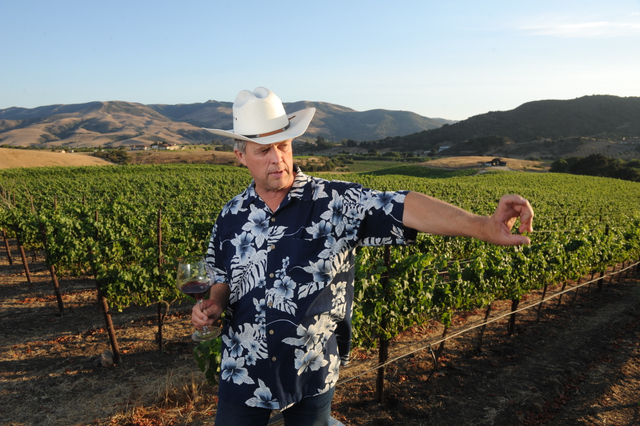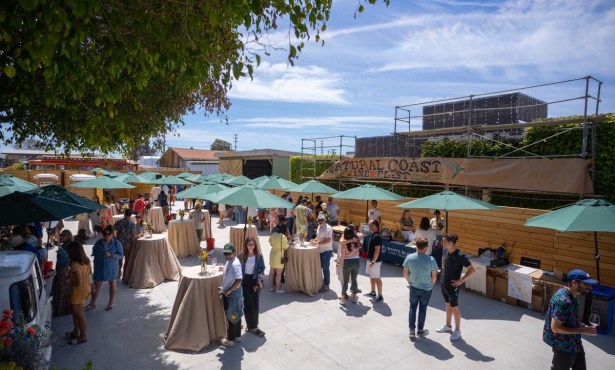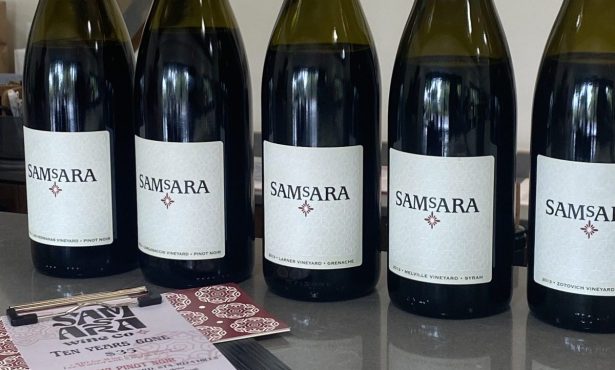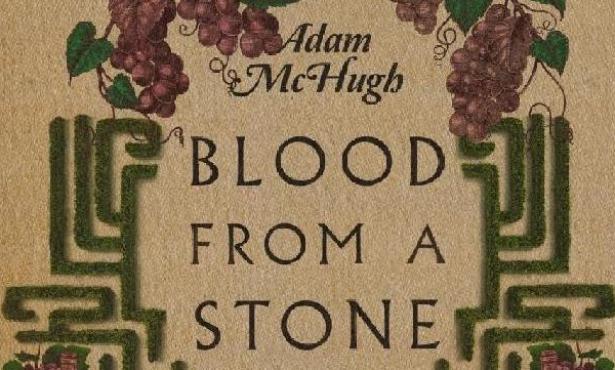My Year in the Vineyard
Learning How to Grow Wine Grapes at Ampelos Vineyard

When you’ve written about drinking wine for more than a decade — and have at least a passing alcohol-producing background due to a few years of home-brewing beer — there comes a time when it’s best to put down the pen, put on the boots, and learn about winemaking from the ground up. In 2012, I did just that, enrolling in what might best be called “Wine 101” at Ampelos Vineyard in the Sta. Rita Hills.
Not only was this a prime spot to understand pinot noir, syrah, and grenache — three of my favorite red grapes — but the 82-acre property is owned by the inimitable Peter Work, the Danish-born former corporate executive who, along with his Alaska-raised wife, Rebecca Work, quit their lucrative careers in 2001 to become full-time vintners after narrowly avoiding the 9/11 attacks while in Manhattan that fateful day. Professorial by nature, Peter is more like a preacher when it comes to discussing his commitment to biodynamic agriculture, a sustainable farming philosophy that’s spreading simply because it makes very vibrant wines. I couldn’t have found a better teacher, classroom, or curriculum.
What follows is a guide to the seasons of a vineyard, based on Work’s insight from more than a decade of study, as well as my experiences tending to the vines last year — which were, admittedly, more symbolic and educational than actually truly productive, as Ampelos vineyard manager Andres Lerena and his crew handle the hard work every day. The end result for me was a barrel of syrah, which we’ll be drinking sometime in 2015, as well as some memorable sweaty experiences under the sun with friends new and old, my young son, and my dad, who passed away suddenly this past May.
PRUNING: After a brief rest around the December holidays, vineyards kick into gear with pruning, when vines are hacked back to a size and shape that will bode well for the months to come. Other than harvest, it’s probably the most physically grueling process, as it requires strong hands to chop away last year’s wood — I found myself quickly sweating in the February sun when I gave it a shot. But like almost every vineyard process, it requires as much mental focus as physical effort.
“At the end of the year, there are dozens of shoots,” said Work, who starts pruning each year on February 1, moving from pinot to syrah to grenache over three weeks. “By pruning, we reduce the number of potential shoots by over 90 percent, which gives the plant a chance to direct its water and nutrient intake to the buds that are left.”
BUD BREAK: Vines in this region tend to come to life in March and April, when green foliage returns to the vines as they emerge from their winter dormancy. “It is the first expression of the energy the vine will demonstrate during the growing season, and it gives us an early indication of the crop level,” said Work. “Once the green material on the buds is even just half an inch, we can see the clusters (called inflorescence) and count how many there are.”
FROST WATCH: Cold spring temperatures can kill emergent buds, and vintners use sprinklers to fight against frost. It sounds counterintuitive to spray water on grapes to fight the cold, but the process of water turning into ice actually produces a small amount of heat and protects the crop. “Frost during the winter when the vines are dormant is not a problem,” said Work, who dealt with frost in 2010 and 2011. “But once there are tiny green leaves and clusters, even an hour of frost can create permanent damage for the year and sometimes for the following, as well.”
SHOOT THINNING: Wine-grape growing is all about finding the balance between stress and strength: Stress forces the vines to make interesting fruit, but you must also direct the energy so that the grape growth is strong enough to deliver a harvest. Stress comes from picking the right sites and soils, and strength comes via processes like shoot thinning, where, at Ampelos, the roughly 60 clusters per vine are knocked down to two dozen.
“It is key throughout the growing season to think about what we want the end result to be at harvest time,” said Work. “Shoot thinning is the first step in this process, and it happens a few weeks after bud-break when the shoots are 8-12 inches long.” In early May, I did a little of this intense, back-bending work, which required lots of double-checking. But the vineyard manager made my day when he looked at my vines and said, “Nice shoot thinning.”
FLOWERING: At Ampelos, flowering occurs for pinot noir from late April to early May, with syrah and grenache following. Vines are self-pollinating, but a little wind and heat helps, though too much would inhibit the fruit set, when grapes begin to grow in earnest. “Rain is not good at this time, because it can knock the flowers off the plants,” said Work, who tracks pollination for up to a month. “We protect against heat and wind by leaving the leaves that the vine has around the clusters, but there is not much else we can do until fruit set is done.” He then taps clusters to see if unpollinated flowers, called shatter, fall into his hands. Too much means a weak crop.
LEAF PULLING: Once grapes are growing, you must ensure that clusters get enough airflow and the right type of gentle sunshine. This process — which actually can occur throughout the rest of the season, depending on how the canopy grows — gets a little sticky and is based on a very specific strategy that vineyard crews must understand. “We go through each vine and pull leaves based on a certain protocol that matches the plant and row direction,” said Work. “Since our pinot noir, syrah, and grenache grow differently, we have a different approach for each.”
VERAISON: Veraison, which means “ripening” in French, is when grapes turn from green to red, which also means, according to Work, that “the birds are arriving, looking for a good restaurant with free meals.” Out come the bird nets! Meanwhile, said Work, “We also carefully maintain our vineyard to keep rodents under control, manage weeds, irrigate as necessary, and apply biodynamic preparations to support the vines during these last critical months of their life.”
HARVEST: In Santa Barbara County’s wide range of vineyard climates, harvest runs from early August to the end of November, depending on what grapes are grown where. “The most critical decision you make as a winemaker is to find the right day for harvest,” said Work, whose usual crew of six pickers and six sorters works under the early morning sun — no wasting energy on electric lights, as some places do — and only handles up to four tons each day in order to take them to the winery while still cold. “This is one of the best times to learn about how each section of the vineyard performs.” At Ampelos, the four rows of syrah that we had selected came due on November 5, so we hand-harvested the whole lot — plus two clusters of nearly ripe grenache — and brought it in a plastic bin to the Ampelos winery on the west end of Lompoc, where I jumped in to crush it with my bare feet, stems and all. Today, the 2012 syrah is sitting in the barrel where it will live for at least another year, when we’ll finally get to sample last year’s learning.



